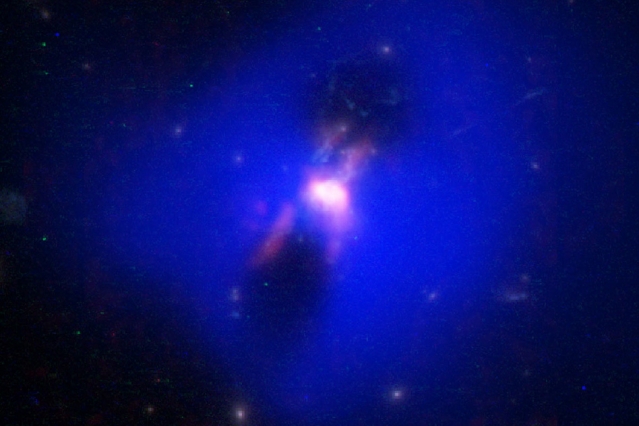
This composite image shows powerful radio jets from the supermassive black hole at the center of a galaxy in the Phoenix Cluster inflating huge “bubbles” in the hot, ionized gas surrounding the galaxy. The cavities inside the blue region were imaged by NASA’s Chandra X-ray observatory. Hugging the outside of these bubbles, ALMA discovered an unexpected trove of cold gas, the fuel for star formation (red). The background image is from the Hubble Space Telescope. Image: ALMA (ESO/NAOJ/NRAO) H.Russell, et al.; NASA/ESA Hubble; NASA/CXC/MIT/M.McDonald et al.; B. Saxton (NRAO/AUI/NSF)
A new discovery that powerful radio jets from a black hole are stimulating the production of cold gas in the galaxy’s extended halo of hot gas has astronomers surprised.
Astronomers using the Atacama Large Millimeter/submillimeter Array (ALMA) discovered the previously unknown connections between an active galactic nucleus (AGN) and the abundance of cold molecular gas that fuels star birth.
“To produce powerful jets, black holes must feed on the same material that the galaxy uses to make new stars,” Michael McDonald, an astrophysicist at the Massachusetts Institute of Technology in Cambridge and coauthor on the paper, said in a statement. “This material powers the jets that disrupt the region and quenches star formation. This illustrates how black holes can slow the growth of their host galaxies.”
Normally powerful radio jets from a black hole will suppress star formation but this newly identified supply of cold, dense gas could eventually fuel future star birth as well as feed the black hole itself.
The researchers used ALMA to study the galaxy at the heart of the Phoenix Cluster, an uncommonly crowded collection of galaxies about 5.7 billion light-years from Earth.
The central galaxy in the cluster harbors a supermassive black hole that is in the process of devouring star-forming gas, which fuels a pair of powerful jets that erupt from the black hole in opposite directions into intergalactic space.
Earlier research with NASA’s Chandra X-ray observatory showed that the jets from this AGN are carving out a pair of giant radio bubbles, huge cavities in the hot, diffuse plasma that surrounds the galaxy.
The expanding bubbles should create conditions that are too inhospitable for the surrounding hot gas to cool and condense, which are essential steps for future star formation.
The astronomers observed long filaments—which extend up to 82,000 light-years from either side of the AGN—of cold molecular gas condensing around the outer edges of the radio bubbles. These filaments collectively contain enough material to make about 10 billion suns.
Helen Russell, an astronomer with the University of Cambridge, UK, and lead author on the paper, explained the observation.
“With ALMA we can see that there’s a direct link between these radio bubbles inflated by the supermassive black hole and the future fuel for galaxy growth,” Russell said in a statement. “This gives us new insights into how a black hole can regulate future star birth and how a galaxy can acquire additional material to fuel an active black hole.”
Without a significant source of heat, most massive galaxies in the universe would be forming stars at extreme rates that far exceed observations.
The astronomers believe that the heat in the form of radiation and jets from an actively feeding supermassive black hole, prevents overcooling of the cluster’s hot gas atmosphere, suppressing star formation.
However, Russell and her team found an additional process that ties the galaxy and its black hole together, where the radio jets that heat the core of the cluster’s hot atmosphere also appear to stimulate the production of the cold gas required to sustain the AGN.
“That’s what makes this result so surprising,” Brian McNamara, an astronomer at the University of Waterloo, Ontario, and co-author on the paper, said in a statement. “This supermassive black hole is regulating the growth of the galaxy by blowing bubbles and heating the gases around it.
“Remarkably, it also is cooling enough gas to feed itself.”
The results could help astronomers understand the workings of the cosmic thermostat that controls the launching of radio jets from the supermassive black hole.
“This could also explain how the most massive black holes were able to both suppress run-away starbursts and regulate the growth of their host galaxies over the past six billion years or so of cosmic history,” Russell said.




